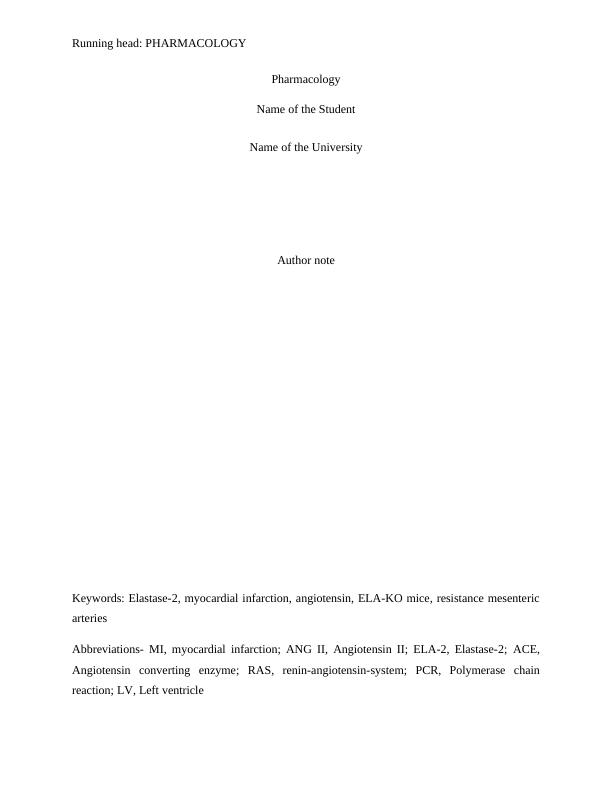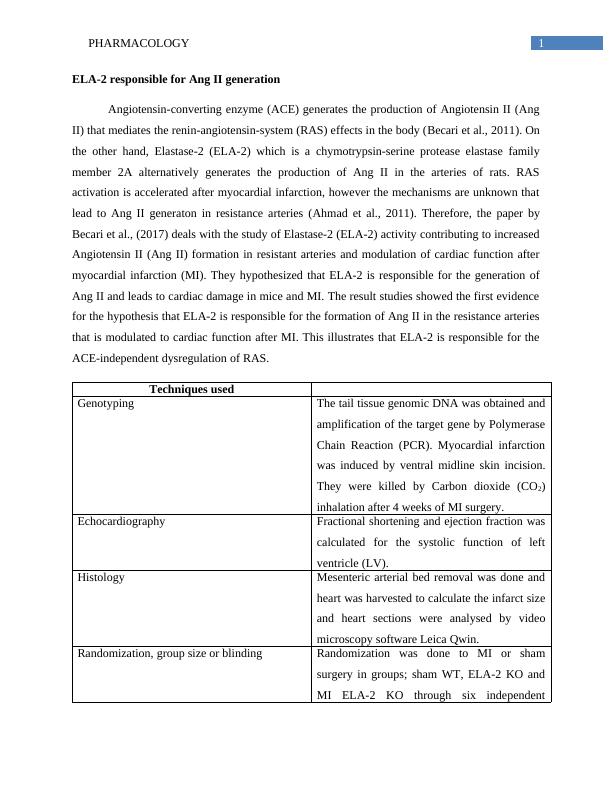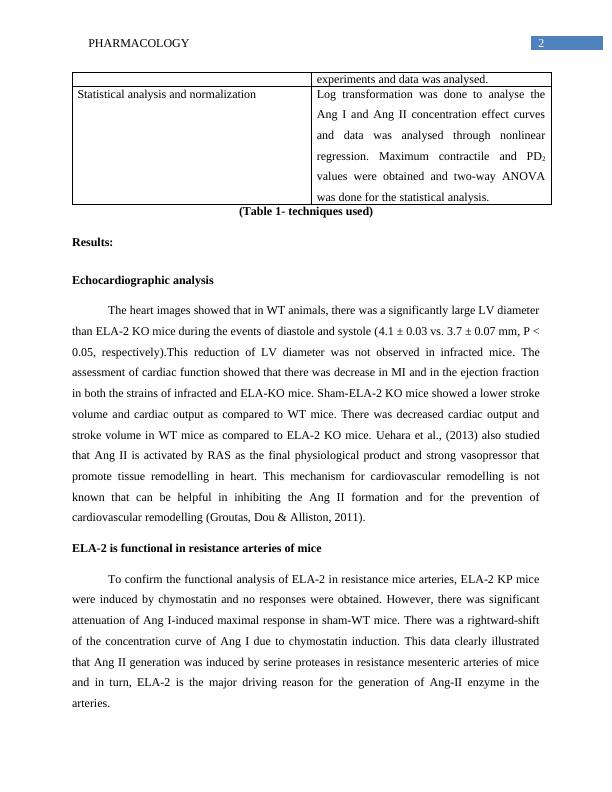Ask a question from expert
Assignment On Pharmacology
6 Pages1658 Words118 Views
Added on 2020-02-24
Assignment On Pharmacology
Added on 2020-02-24
BookmarkShareRelated Documents
Running head: PHARMACOLOGY PharmacologyName of the StudentName of the UniversityAuthor noteKeywords: Elastase-2, myocardial infarction, angiotensin, ELA-KO mice, resistance mesentericarteriesAbbreviations- MI, myocardial infarction; ANG II, Angiotensin II; ELA-2, Elastase-2; ACE,Angiotensin converting enzyme; RAS, renin-angiotensin-system; PCR, Polymerase chainreaction; LV, Left ventricle

1PHARMACOLOGYELA-2 responsible for Ang II generation Angiotensin-converting enzyme (ACE) generates the production of Angiotensin II (AngII) that mediates the renin-angiotensin-system (RAS) effects in the body (Becari et al., 2011). Onthe other hand, Elastase-2 (ELA-2) which is a chymotrypsin-serine protease elastase familymember 2A alternatively generates the production of Ang II in the arteries of rats. RASactivation is accelerated after myocardial infarction, however the mechanisms are unknown thatlead to Ang II generaton in resistance arteries (Ahmad et al., 2011). Therefore, the paper byBecari et al., (2017) deals with the study of Elastase-2 (ELA-2) activity contributing to increasedAngiotensin II (Ang II) formation in resistant arteries and modulation of cardiac function aftermyocardial infarction (MI). They hypothesized that ELA-2 is responsible for the generation ofAng II and leads to cardiac damage in mice and MI. The result studies showed the first evidencefor the hypothesis that ELA-2 is responsible for the formation of Ang II in the resistance arteriesthat is modulated to cardiac function after MI. This illustrates that ELA-2 is responsible for theACE-independent dysregulation of RAS. Techniques usedGenotypingThe tail tissue genomic DNA was obtained andamplification of the target gene by PolymeraseChain Reaction (PCR). Myocardial infarctionwas induced by ventral midline skin incision.They were killed by Carbon dioxide (CO2)inhalation after 4 weeks of MI surgery. EchocardiographyFractional shortening and ejection fraction wascalculated for the systolic function of leftventricle (LV). HistologyMesenteric arterial bed removal was done andheart was harvested to calculate the infarct sizeand heart sections were analysed by videomicroscopy software Leica Qwin. Randomization, group size or blindingRandomization was done to MI or shamsurgery in groups; sham WT, ELA-2 KO andMI ELA-2 KO through six independent

2PHARMACOLOGYexperiments and data was analysed. Statistical analysis and normalization Log transformation was done to analyse theAng I and Ang II concentration effect curvesand data was analysed through nonlinearregression. Maximum contractile and PD2values were obtained and two-way ANOVAwas done for the statistical analysis. (Table 1- techniques used)Results:Echocardiographic analysis The heart images showed that in WT animals, there was a significantly large LV diameterthan ELA-2 KO mice during the events of diastole and systole (4.1 ± 0.03 vs. 3.7 ± 0.07 mm, P <0.05, respectively).This reduction of LV diameter was not observed in infracted mice. Theassessment of cardiac function showed that there was decrease in MI and in the ejection fractionin both the strains of infracted and ELA-KO mice. Sham-ELA-2 KO mice showed a lower strokevolume and cardiac output as compared to WT mice. There was decreased cardiac output andstroke volume in WT mice as compared to ELA-2 KO mice. Uehara et al., (2013) also studiedthat Ang II is activated by RAS as the final physiological product and strong vasopressor thatpromote tissue remodelling in heart. This mechanism for cardiovascular remodelling is notknown that can be helpful in inhibiting the Ang II formation and for the prevention ofcardiovascular remodelling (Groutas, Dou & Alliston, 2011). ELA-2 is functional in resistance arteries of mice To confirm the functional analysis of ELA-2 in resistance mice arteries, ELA-2 KP micewere induced by chymostatin and no responses were obtained. However, there was significantattenuation of Ang I-induced maximal response in sham-WT mice. There was a rightward-shiftof the concentration curve of Ang I due to chymostatin induction. This data clearly illustratedthat Ang II generation was induced by serine proteases in resistance mesenteric arteries of miceand in turn, ELA-2 is the major driving reason for the generation of Ang-II enzyme in thearteries.

End of preview
Want to access all the pages? Upload your documents or become a member.
Related Documents
PHARMACOLOGY - Angiotensin-Converting Enzyme | Assignmentlg...
|8
|1240
|42